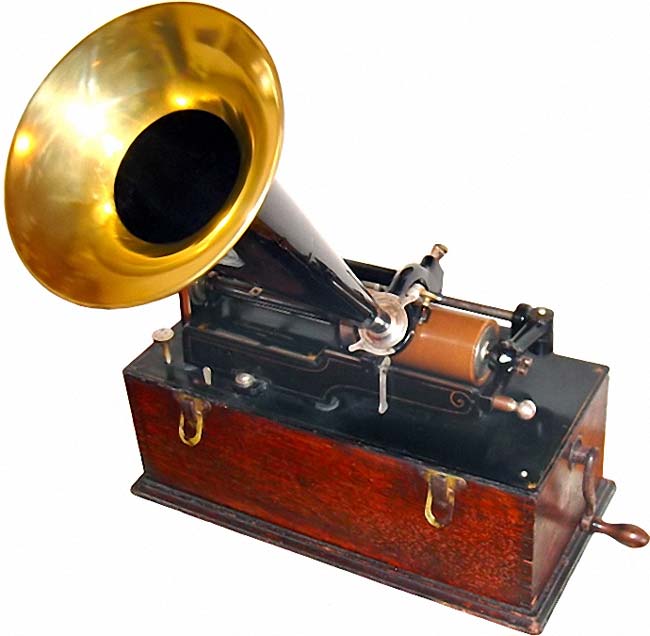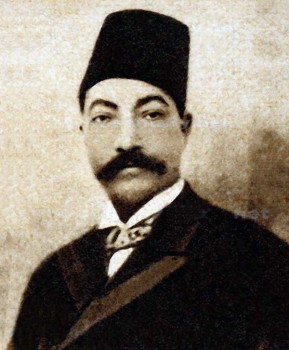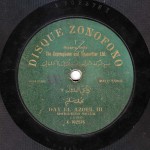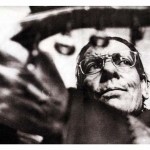
Edison recording Phonograph 1899
Dawr “Inta farīd fī el-ḥusn” was written by Ismā‘īl Bāshā Ṣabrī and composed by ‘Abduh Afandī al-Ḥāmūlī to the ḥijāz maqām.
Madhhab:
Inta farīd fī el-ḥusn wallāk gamālak Yā ḥilwi wāṣil we-kīd el-a‘ādī
Yikfa dalālak
Dawr:
Mīn ‘allimak ‘a-el-dalāl Wallā dā ṭab‘ak
Yā ḥilwi wāṣil we-kīd el-a‘ādī We-uḥkum bi-shar‘ak
In this episode, we will study two recordings.
The first recording is of ‘Abd al-Ḥayy Afandī Ḥilmī, made in 1909 by Odeon on two sides of a 27cm record, order # 45751 / 1 and 2, matrix # XE.2301 / a and b.

Sulaymān Afandī Abū Dāwūd
The second recording is of Sulaymān Afandī Abū Dāwūd, made the same year or a year later by Baidaphon –known as the “National Company” at the time– on two sides of a 27cm record, # 1700 and 1701.
Let us start our analysis.
The structure of dawr “Inta farīd fī el-ḥusn” is very simple: this dawr was created during the transitional phase between:
The dawr’s simple structure –ex: “Yā ḥlēwa yā msallīnī” by ‘Abd al-Raḥīm al-Maslūb–;
And its more complicated structure –ex: “Yā ma-inta waḥishnī” by Muḥammad ‘Uthmān, the adwār by Dāwūd Ḥusnī or Ibrāhīm al-Qabbānī, or all the adwār whose structure is more developed than the simple dawr’s.

‘Abduh Afandī al-Ḥāmūlī
Today, we will be studying dawr “Inta farīd fī el-ḥusn” composed by Sī ‘Abduh al-Ḥāmūlī during the transitional phase.
Neither is its structure simple, i.e. a repetitive melody and tafrīd, nor is its pattern long and set, with many shifts and melodic displays to the original maqām, or anything else…
It is in between both, i.e. it includes a madhhab to the maqām, and we will later learn that its pattern type is simple.
Today, we have a surprise for you concerning the presentation of the madhhab.
We will listen to it in the two recordings mentioned earlier: the recording of Sulaymān Abū Dāwūd and the recording of ‘Abd al-Ḥayy Ḥilmī.
Before these two recordings, we will listen to the madhhab recorded by Sī ‘Abduh himself on a cylinder record before 1900.
His version of the madhhab is different from the versions of ‘Abd al-Ḥayy, Sulaymān Abū Dāwūd, and even Al-Manyalāwī, or any other singer who performed it after this strange cylinder recording was made.
Sī ‘Abduh recorded it on a wax cylinder usṭuwāna (record) –that resembles a bobbin, and thus its name usṭuwāna (record) that remained even after it became a disc. We will discuss this in a separate episode.
We have decided to present this recording because it is rare of course, but also because the way Sī ‘Abduh fragments the debit of the phrase “Yā ḥilwi wāṣil we-kīd el-a‘ādī” is different from the way it is delivered by those we are used to hearing singing it…
(♩)
And who do not pronounce the “hamza” (glottal stop) whereas Sī ‘Abduh does…
(♩)
He pronounces the “hamza” and fragments the debit of the lyrics as if he were dealing with proper Arabic language, i.e. he delivers the lyrics in a fragmented manner in order to follow the melody (it is not the melody that follows the lyrics, but the other way around).
Let us listen to the madhhab performed by these three singers.
Sī ‘Abduh seems to be playing the ‘ūd, accompanied by Ḥasan al-Jāhid or Ibrāhīm Sahlūn –we can’t know for sure– (kamān).
‘Abd al-Ḥayy Ḥilmī is accompanied by the instrumental interpretation of Ibrāhīm Sahlūn (kamān) and Muḥammad Ibrāhīm (qānūn). There is also a very pleasant percussionist playing, but we do not know his name.
In Sulaymān Abū Dāwūd’s recording made by Baidaphon, he is accompanied by the marvellous interpretation of ‘Abd al-Ḥamīd al-Quḍḍābī (qānūn) and Sāmī al-Shawwā (kamān).
Let us listen to the three versions of the madhhab.
(♩)
As mentioned earlier, the dawr was composed to the ḥijāz maqām, but its sub-maqām oscillates between the ‘ushshāq and the rāst.
We will learn that he meant to bring forward the ‘ushshāq through the display of tafrīd. At the beginning of this tafrīd, he asks whoever sings this dawr to bring forward the ‘ushshāq.

‘Abd al-Ḥayy Afandī Ḥilmī
Whereas ‘Abd al-Ḥayy Ḥilmī had no wish to bring forward the ‘ushshāq and decided to go through it in a glimpse then quickly shift to the rāst sub-maqām.
Let us listen to ‘Abd al-Ḥayy.
(♩)
Sulaymān wished to perform salṭana while abiding by the intricacies of the dawr’s pattern, not revolting against them like ‘Abd al-Ḥayy.
Let us listen to Sulaymān Abū Dāwūd and note how he focuses on the ‘ushshāq in the tafrīd…
(♩)
Let us now listen to Sulaymān Abū Dāwūd performing the shift to the rāst.
Note the interpretation by Sāmī al-Shawwā, and his accompaniment, and how he goes down to the qarār through great aesthetics that beautify Sulaymān Abū Dāwūd’s singing.
Also note how the instruments are not only there as an accompaniment: they add beauty to the work. They do not merely complete it, they are a part of it.
Let us listen to this shift in Sulaymān Abū Dāwūd’s phrase, and to the band performing with him…
(♩)
Wow! Beautiful!
This dawr does not include compulsory henk i.e. tarannum (“āh” or “yā lēl). The tarannum is not there at all and whoever is singing this dawr is not required to perform a tarannum.
Yet ‘Abd al-Ḥayy decided to insert into the dawr a type of tarannum that includes āhāt and people responding.
Let us listen to this…
(♩)
Sulaymān Abū Dāwūd, with his habitual abiding by the rules, did not perform any tarannum or henk. He went directly into the “Mīn ‘allimak mīn” part, i.e. the waḥāyid between the solo muṭrib and the biṭāna.
Sulaymān Abū Dāwūd only performed one tafrīda. Here it is.
(♩)
‘Abd al-Ḥayy Ḥilmī’s performance is playful and coquettish, which gave the dawr a pleasant and delightful character that may not be present in the original dawr.
‘Abd al-Ḥayy delivers the “Mīn ‘allimak ‘a-el-dalāl, Wallā dā ṭab‘ak” part with a kind of cute “blame” and a smile clearly displayed in “ ‘A-el-dalāl, ‘a-el-dalāl”, in the way the biṭāna answer him, and in the way he “flirts” with the lyrics.
Let us listen to ‘Abd al-Ḥayy and note the beauty and delight he adds to the dawr. This joyfulness is missing in his other performances that are usually full of sadness and despair.
Here, he is very joyful.
(♩)
The conclusion of the dawr:
‘Abd al-Ḥayy goes back to the ḥijāz.
Sheikh Yūsuf also goes back to the ḥijāz in his recording.
But Sulaymān Abū Dāwūd does not go back to the ḥijāz. He performs the finale to the rāst, the same as Sī ‘Abduh in his wax cylinder recording.
But did Sī ‘Abduh mean to perform the finale to the rāst or not? We do not really know.
Sheikh Yūsuf, in his recording, performs the finale to the ḥijāz, the same as ‘Abd al-Ḥayy who, moreover, is the only one who sings the conclusion phrase “Ismaḥ wugūd bi-el-wiṣāl, We-uḥkum bi-shar‘ak”. It is different from the phrases written in books. He probably took it from Sī ‘Abduh as he used to sing in the latter’s biṭāna.
Let us listen to ‘Abd al-Ḥayy’s conclusion.
(♩)
It is different from Sheikh Yūsuf’s conclusion, and from the conclusions performed by all the others, including those who perform the finale to the ḥijāz.
Whether their finale is to the ḥijāz or to the rāst, ‘Abd al-Ḥayy’s conclusion remains completely different.
Sheikh Yūsuf’s recording made by Gramophone can be listened to within the Complete Collection of his Works published by AMAR in 2011 on the occasion of the centenary of the death of Sheikh Yūsuf.
‘Abd al-Ḥayy’s recording can also be listened to in full within the ‘Abd al-Ḥayy Ḥilmī Collection of Selected Works published by AMAR in 2013, also on the occasion of the centenary of ‘Abd al-Ḥayy Ḥilmī’s death –101 years actually, but one year difference is not a big deal.
Consequently, we must podcast Sulaymān Abū Dāwūd’s recording in full because of its rarity.
Sulaymān Abū Dāwūd’s recording starts with a dūlāb to the ḥijāz. Then he sings the dawr and concludes to the rāst 4th scale step followed by layālī to the ḥijāz and marvellous taqāsīm played by Sāmī al-Shawwā.
Let us listen to Sulaymān Afandī Abū Dāwūd singing the dawr. He does take the pattern into account, yet his performance includes great tafrīdāt as well as delight and the guttural pronunciation of the māshayish even though he is an afandī.
His is a strange spirit, somewhere between a māshayish’s and an afandīs’.
Let us listen to Sulaymān Afandī Abū Dāwūd…
(♩)
Beautiful, Sulaymān Afandī Abū Dāwūd!
Dear listeners, we have reached the end of today’s episode of “Sama‘ ”.
We will meet again in a new episode to analyse another work.
“Sama‘ ” is brought to you by AMAR.
- 221 – Zakariyya Ahmed – 12 (1/9/2022)
- 220 – Zakariyya Ahmed – 11 (1/9/2022)
- 219 – Zakariyya Ahmed – 10 (11/25/2021)
- 218 – Zakariyya Ahmed – 9 (10/26/2021)
- 217 – Zakariyya Ahmed – 8 (9/24/2021)
- 216 – Zakariyya Ahmed – 7 (9/4/2021)
- 215 – Zakariyya Ahmed – 6 (8/28/2021)
- 214 – Zakariyya Ahmed – 5 (8/6/2021)
- 213 – Zakariyya Ahmed – 4 (6/26/2021)
- 212 – Zakariyya Ahmed – 3 (5/27/2021)
- 211 – Zakariyya Ahmed – 2 (5/1/2021)
- 210 – Zakariyya Ahmed – 1 (4/28/2021)
- 209 – W-al-Lāhi lā astaṭī‘u ṣaddak 2 (4/6/2017)
- 208 – W-al-Lāhi lā astaṭī‘u ṣaddak 1 (3/30/2017)
- 207 – Bashraf qarah baṭāq 7 (3/23/2017)


